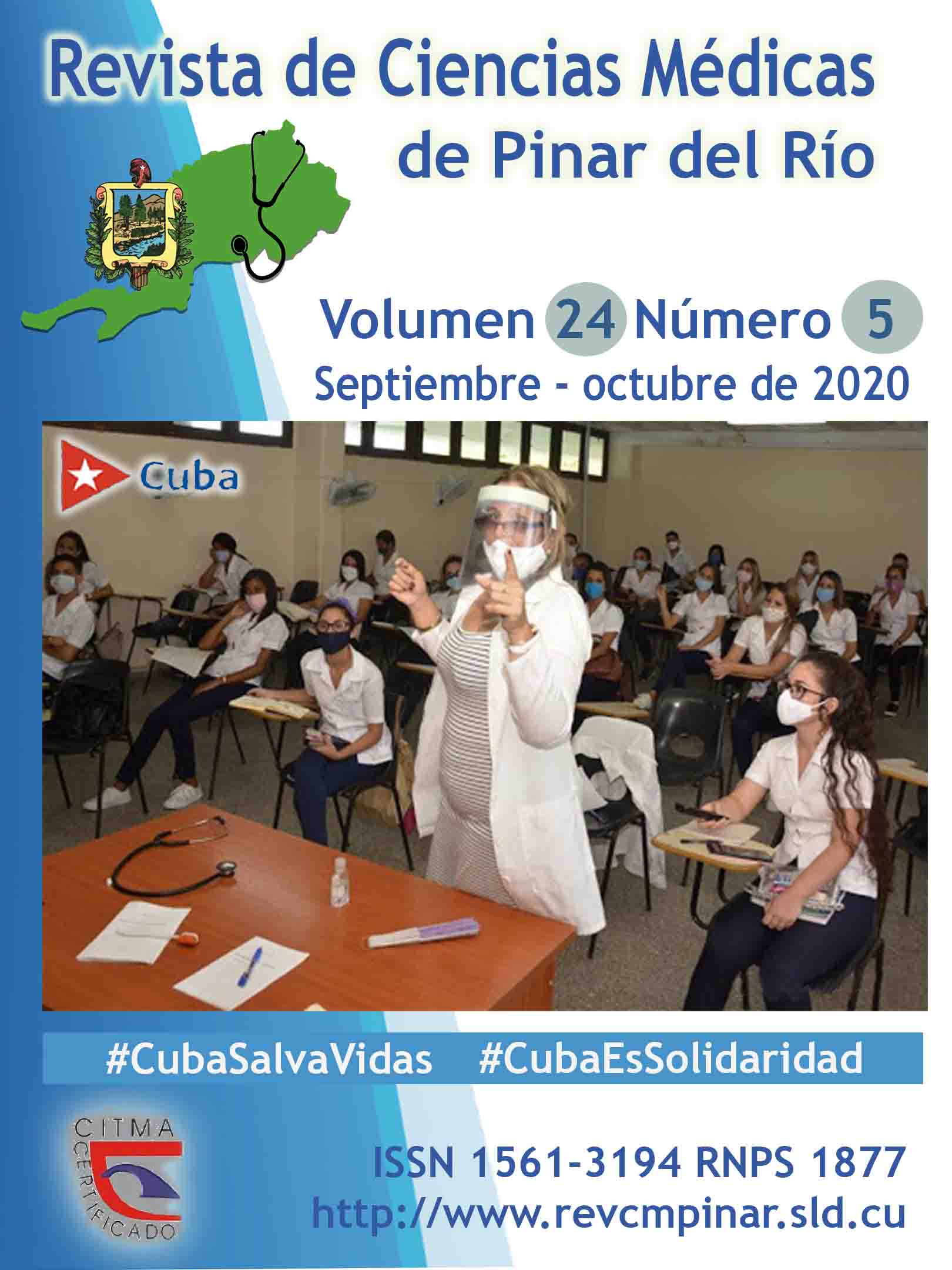The process to cope with COVID-19 supported by the control environment
Keywords:
COVID-19, INTERNAL CONTROL, CONTROL ENVIRONMENT, HEALTH HUMAN CAPITAL, PROCESS APPROACH.Abstract
Introduction: the lack of references to crises similar to COVID-19 in the past makes it difficult to predict what may happen in the immediate future. Logically, the present effects of this pandemic are without doubt documented, but those that will leave their mark on the different protagonists at medium and long-term are more subject to debate.
Objectives: to demonstrate the role of the control environment as a basis for the internal control in coping with COVID-19.
Methods: the strategy to cope with COVID-19 is designed; the role of the elements that are involved in the control environment and the relationship with the process of human-health capital is evidenced.
Results: the process map to develop the strategy to cope with COVID-19 where the internal control is materialized in a cross-sectional approach, as the significance of the elements involved in the control environment such as: planning, ethical values, proven competences, organizational structure in addition to the human resources policies, and the practices, as well as the relationships with the actions established to direct the human-health capital.
Conclusions: the impact reflected to cope with this pandemic along with the elements of the control environment, as the basis for the cross-sectional process (internal control) designed for the strategy to cope with COVID-19, as well as the importance of the processes and the relationships to direct the elements involved in human-health capital, allow establishing a strategy of improvement based on an action plan.
Downloads
References
1. Serra Valdés MA. Infección respiratoria aguda por COVID-19: una amenaza evidente. Revhabanciencméd [Internet]. 2020 [citado 12/05/2020]; 19(1):1-5. Disponible en: http://www.revhabanera.sld.cu/index.php/rhab/article/view/3171
2. Dirección General de Salud Pública, Calidad e Innovación. Procedimiento de actuación frente a casos de infección por el nuevo coronavirus (SARS-CoV-2) [Internet]. La Habana: Dirección General de Salud Pública; 2020 [citado 12/05/2020]. Disponible en: https://www.mscbs.gob.es/profesionales/saludPublica/ccayes/alertasActual/nCovChina/documentos/Procedimiento_COVID_19.pdf
3. Ministerio de Salud Pública de Cuba. Protocolo Nacional MINSAP vs COVID-19 [Internet]. La Habana: MINSAP; 2020 [citado 12/05/2020]. Disponible en: https://files.sld.cu/sars/files/2020/04/Protocolo-provisional-de-Cuba-vs-COVID-4abril2020.pdf
4. Centro Nacional de Información de Ciencias Médicas/INFOMED. Coronavirus 2019 actualización [Internet]. La Habana: Centro Nacional de Información de Ciencias Médicas/INFOMED; 2020 Feb 17[Citado 12/05/2020]. Disponible en: https://temas.sld.cu/coronavirus/2019ncov/actualización17defebrerode2020
5. Vega de la Cruz LO, Gonzáles Reyes LL. Diagnóstico estadístico del control interno en una institución hospitalaria. Revhabanciencméd [Internet]. 2017 Abr [citado 13/11/2017]; 16(2): 295-309. Disponible en: http://scielo.sld.cu/scielo.php?script=sci_arttext&pid=S1729-519X2017000200015&lng=es
6. Vega de la Cruz LO, Herrera González Y, González Reyes LL, Cantero Cora H. Construcción de futuros en una institución hospitalaria cubana. AMC [Internet]. 2017 Jun [citado 19/02/2020]; 21(3): 348-360. Disponible en: http://scielo.sld.cu/scielo.php?script=sci_arttext&pid=S1025-02552017000300006&lng=es.
7. Vega de la cruz LO, Lao Leon YO, Nieves Julbe AF. Propuesta de un índice para evaluar la gestión del control interno. Contaduría y administración[Internet]. 2017 Jun [citado 19/02/2020]; 62(2): 683-698. Disponible en: https://dx.doi.org/10.1016/j.cya.2017.01.004
8. Contraloría General de la República de Cuba. Normas del Sistema de Control Interno, Resolución 60, 2011
9. Ramírez Betancourt F, Ramos Alfonso Y, Petersson Roldán M, Ramírez Hernández JA, García Rodríguez E. ¿Eficiente administración sanitaria? Caso clínica estomatológica. RevMed Electrón [Internet]. 2014 Abr [citado 09/02/2016]; 36(2): 160-170. Disponible en: http://scielo.sld.cu/scielo.php?script=sci_arttext&pid=S1684-18242014000200005&lng=es
10. Casas López MJ, Díaz Bernal Z, Martínez Cabrera A, Cernuda A, Borile M. Manejo de la ética ante un adolescente con sospecha de sida. RevMed Electrón [Internet]. 2015 Dic [citado 09/02/2016]; 37(6): 627-634. Disponible en: http://scielo.sld.cu/scielo.php?script=sci_arttext&pid=S1684-18242015000600008&lng=es
11. Padilla Suárez E, Suárez Isaqui L, Troya Borges E, Martínez Abreu J. La evaluación médica en la atención primaria de salud. Rev. Med. Electrón. [Internet]. 2014 Abr [citado 09/02/2016]; 36(2): 230-237. Disponible en: http://scielo.sld.cu/scielo.php?script=sci_arttext&pid=S1684-18242014000200013&lng=es
12. Cabrera S, Martínez Clavel L, HérnandezRoman M. COVID-19. Visión del anestesiólogo. Rev Cuban Cardiol [Internet]. 2020 [citado 12/05/2020]; 26(1): [aprox. 3p.]. Disponible en:http://www.revcardiologia.sld.cu/index.php/revcardiologia/article/view/953
13. Naranjo Domínguez A, Valdés Martín A. COVID-19. Punto de vista del cardiólogo. Rev Cuban Cardiol[Internet]. 2020 [citado 12/05/2020]; 26(1):[aprox. 1p.]. Disponible en: http://www.revcardiologia.sld.cu/index.php/revcardiologia/article/view/951
14. Vidal Ledo M, Guinovart Díaz R, BaldoquínRodriguez W, Valdivia Onega NC, Morales Lezca W. Modelo matemático para el control epidemiológico. Revista Educación Médica Superior [Internet]. 2020 Abril [citado 19/05/2020]; 34(2): 2387. Disponible en: http://www.ems.sld.cu/index.php/ems/article/view/2387/972
15. Figueredo Reinaldo O, Padrón Padilla A, Carmona Tamayo E. COVID-19 en Cuba: El pico se adelanta, ¿qué dicen los modelos matemáticos y cómo interpretarlos? CUBADEBATE. 2020 May [acceso 06/05/2020]. Disponible en: http://www.cubadebate.cu/especiales/2020/04/27/covid-19-en-cuba-el-pico-se-adelanta-que-dicen-los-modelos-matematicos-y-como-interpretarlos/#.XqyxHM3B-60
Downloads
Published
How to Cite
Issue
Section
License
Authors who have publications with this journal agree to the following terms: Authors will retain their copyrights and grant the journal the right of first publication of their work, which will be publication of their work, which will be simultaneously subject to the Creative Commons Attribution License (CC-BY-NC 4.0) that allows third parties to share the work as long as its author and first publication in this journal are indicated.
Authors may adopt other non-exclusive license agreements for distribution of the published version of the work (e.g.: deposit it in an institutional telematic archive or publish it in a volume). Likewise, and according to the recommendations of the Medical Sciences Editorial (ECIMED), authors must declare in each article their contribution according to the CRediT taxonomy (contributor roles). This taxonomy includes 14 roles, which can be used to represent the tasks typically performed by contributors in scientific academic production. It should be consulted in monograph) whenever initial publication in this journal is indicated. Authors are allowed and encouraged to disseminate their work through the Internet (e.g., in institutional telematic archives or on their web page) before and during the submission process, which may produce interesting exchanges and increase citations of the published work. (See The effect of open access). https://casrai.org/credit/



